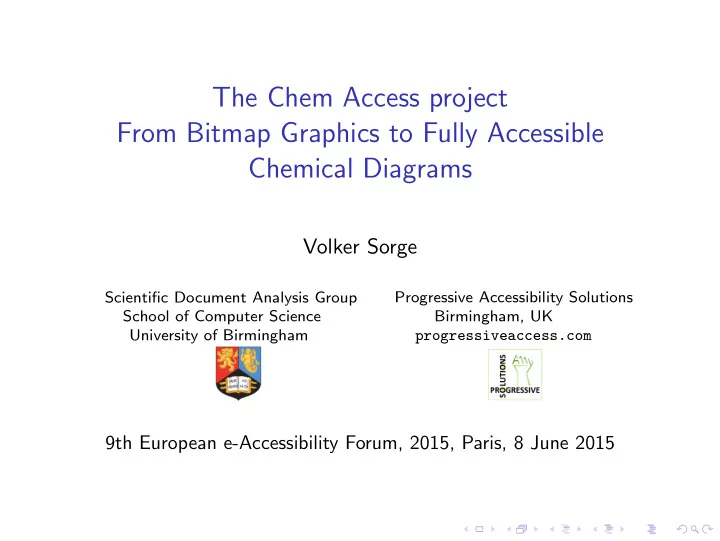

The Chem Access project From Bitmap Graphics to Fully Accessible Chemical Diagrams Volker Sorge Scientific Document Analysis Group Progressive Accessibility Solutions School of Computer Science Birmingham, UK University of Birmingham progressiveaccess.com 9th European e-Accessibility Forum, 2015, Paris, 8 June 2015
Motivation ◮ Accessibility to STEM material is important issue for inclusive education ◮ Diagrams are an important teaching means in STEM ◮ Chemical diagrams (depictions of molecules) are ubiquitous in teaching from GCSE and A-levels teaching to undergrad curriculum chemistry, biosciences, life sciences. ◮ Previous work on assistive technology for chemical diagrams ◮ Require diagrams to be drawn in particular way or authoring environment ◮ Need for specialist software to access and interact with diagrams ◮ Additional hurdles for both authors and readers
Goals ◮ Make regular teaching material accessible ◮ From inaccessible image to support for independent learning ◮ Source independence ◮ Do not rely on the benevolent, educated author ◮ Platform independence ◮ Use standard web technology (HTML5) ◮ Accessible with all browsers, screen readers ◮ Provide a seamless user experience without/very little interface ◮ Support diverse material, for novices and experts alike
Examples ◮ Different representations of Aspirin molecule. Displayed formula. Skeletal formula. Structural formula.
Examples ◮ Or somewhat more complex.
Procedure Input: A bitmap image of a molecule diagram 1. Image analysis and recognition 2. Generation of annotated SVG 3. Semantic enrichment 4. Accessible diagram via browser front-end
Image Segmentation MolRec system implemented for diagram recognition on patent databases ◮ Initial preprocessing: Binarisation, noise reduction. . . ◮ Connected component extraction and labelling ◮ Optical Character recognition and removal ◮ Separation of bond elements ◮ Walk skeleton diagram structure ◮ Identify and break junction points ◮ Result is a set of geometric primitives: Character groups, lines, circles, triangles
Diagram Recognition ◮ Rule based system ◮ Rewrites bag of geometric primitives into a graph representation ◮ Example: 1. Let l 1 , l 2 be distinct line segments of a minimum length. 2. If l 1 is nearly parallel to and in a neighbourhood of l 2 . 3. No other line segment is nearly parallel to l 1 or l 2 . ⇒ Then ( l 1 , l 2 ) form a double bond. single double triple wedge dashed wedge wavy ◮ Result is a Chemical Markup File (CML or MOL)
SVG Generation ◮ Many solutions for generating SVG from chemical markup ◮ But they only draw! ◮ And in the process destroy any structure or chemical knowledge ◮ Build our own SVG generator with emphasis on ◮ Grouping meaningful units together (e.g., double bonds) ◮ Retaining names given to components in the chemical markup (IDs of atoms, bonds, etc.) ◮ Result annotated and grouped SVG
Semantic Enrichment ◮ Take basic chemical markup: Enrich it with derived knowledge and structure it accordingly ◮ Detect major building blocks of the molecule ◮ Aliphatic chains ◮ Ring systems: Isolated and fused ◮ Functional groups ◮ Order blocks and atoms by chemical conventions ◮ Naming and description ◮ Cactus webservice ◮ Basic descriptions via atoms, bonds, substitutions
Abstraction Graph ◮ Represent molecule as multi-layered graph ◮ 3-4 layers of abstraction ◮ Molecule ◮ Block ◮ Atom ◮ Additional layer in case of fused ring systems ◮ Result semantically enriched CML File
Accessibility Support via Browser Front-end ◮ Graph structure can serve as the bases for interacting with the molecule ◮ Very simple navigation model: down/up, right/left ◮ Top: Aspirin ◮ Middle: Benzene ring ↔ Ester group ↔ Carboxylic acid group ◮ Lowest: Carbon 1 double bonded ↔ Carbon2 single bonded ↔ Carbon 3 . . . ◮ Generic browser front-end using standard web technology (HTML5, SVG, JavaScript, ARIA) ◮ Screen Reader: Generate speech output from CML graph, implementing two levels of expertise ◮ Low Vision/Learning Disability: highlightinh, magnification, contrast change, colour configuration
Conclusions ◮ User testing: “Molimod testing”, “Phone-experiments”, . . . ◮ Integrates seamlessly without need for bespoke tools ◮ End-to-end procedure from images to accessible diagrams ◮ Don’t need to rely on author cooperation ◮ Demo of web front end later today http://progressiveaccess.com/chemistry Next steps: ◮ Tactile diagrams, 3D printing, Localisation ◮ Other STEM subjects: Physics (circuit diagrams), Maths (geometry, bearings), Biology (phylogenetic trees), Computer Science (flow charts) Acknowledgements: Mark G. Lee, Sandy Wilkinson , Duncan Bell, Peter Murray-Rust, Egon Willighagen, John May, Noureddin Sadawi, John Saxon, students and teachers of NCW
Recommend
More recommend